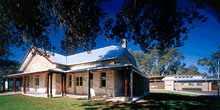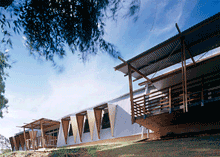How they work

Alison's design work is inspired by the landscape and its natural forms. When designing she keeps in mind the Aboriginal notion of our physical connection to the land . Often, she will use her camera to photograph the landscape, focusing on both large areas and tiny details. She is particularly interested in the patterns and forms that repeat themselves in nature and in all living things. For example, for a project she worked on at La Perouse in Sydney, a huge 4-storey sunshade depicts a close-up of a butterfly's wing.
Alison says that she avoids looking at too many design magazines as she prefers not to be influenced by trends and fashion. She tries to approach a design in the way that an artist would ? looking at the people that live there now, its history and the people that have lived there in the past ? and relating that to the site. She believes that Australia needs to develop its own visual style and not just copy the buildings and interiors found in Europe and other parts of the world.
Alison admires the work of architect Glenn Murcutt. She says, his elegant sheds feel like living parts of the landscape. She also appreciates the way that Murcutt uses passive environmental principles. This might include clever ventilation that decreases energy consumption. She also likes his use of environmentally friendly materials and the way that his buildings appear to touch the ground lightly ensuring that the impact to the earth is minimal.
Working with clients
When working with communities, Alison and her colleagues will help the community to define their ideas. Often, she is asked to represent an Indigenous community's totem in some way, for example, she might use a goanna's markings on the roof of a building or she might use an interesting abstract shape inspired by a totem. All the ideas come from the community and so Alison needs to have an idea of what buildings they like. She also needs to learn about the traditions of those people.
"You need to be very humble and very open and willing to follow any protocols that they may or may not have. It's like if you go to a Japanese person's place, it's probably appropriate for you to take your shoes off if they want you to. So when you go into an Aboriginal community it's exactly the same."
"When you initially go into a community, it is important to spend as much time as the project will allow, as quite often, it is the first time that a community has been asked particular questions. The first time I went to Maralinga, for the first week, I think most people thought I was the new nurse, but I made myself visible and by the end of the second week most people came to talk to me and I was able to ask them ideas for the project."
Materials and environmental principles
Alison's work uses a lot of environmentally friendly materials. She says that the materials she uses really depend on the kinds of skills and resources available in the community she is working in. For example, if there are a lot of carpenters, she will use more wood. She loves to use contemporary materials like glass, stainless steel, plastics and rubber alongside more traditional materials.
One of Alison's aims is to design buildings that are sustainable, not only in their structure and the materials used, but also in terms of on-going maintenance. She likes to use lightweight materials such as aluminium frames and corrugated iron walls with buildings sitting up off the ground allowing air to flow freely beneath. It is also important that the buildings have fewer points of contact to the ground.
  |
The Wilcannia Hospital project
One of the most successful projects that Alison has worked on was the Wilcannia Hospital Redevelopment nearly 1 000 km north-west of Sydney. The site, on the Darling River, contained an old sandstone house facing the street. This colonial structure was problematic for Indigenous people because they felt that they were turning their back on the river, a source of life. After consultation with the community, the project team included a new shed-like structure made of earth brick and corrugated iron with many places where people could sit and enjoy the river. The new building also aimed to bring a sense of harmony between the site's old colonial history and the needs of contemporary Indigenous communities.
The design practice
Alison runs her own design practice from her home in a quiet little seaside town on the northern coast of NSW. She enjoys a more relaxed pace of life and relies on the Internet, telephone and fax to conduct her business. Generally she is employed by different organisations as a consultant on interior design projects such as office fit-outs. This usually involves overseeing the work carried out by the many professionals who form part of the project team.
How they do it: the design process
Setting fees
Alison uses the Architecture Institute's standard list of professional rates as a guide. These standards provide different rates depending on the kind of work being done. Then Alison works out what has to be done and how long it is going to take. There may also be some added costs for travelling out to remote areas. She is often asked to do work for free but insists that this is not a good way to work.
"You can't work for free as it doesn't help. You need to be professional and have integrity. You charge what it costs for you to do it without making a massive profit. Setting fees is also a good way to put limits on the process. Otherwise you could just keep on designing and never stop."
Having built a solid reputation in a specific area of interior design, she has no shortage of work.
"There's a saying ?you don't use the old Telecom system, you tell-a-Koori'. That's kind of the way our marketing has worked. If we do well in one community, then the next community will find out about it. We haven't done a lot of marketing or advertising except we try and turn up at the right places, like Careers Day for young people. Because that sort of thing goes a long way in terms of the community knowing where you're coming from."
Copyright and intellectual property
For Alison, the community owns the right to the story that the designers are telling. All ideas are generated from the community and therefore belong to them. Unlike many other design areas, Alison does not tend to have any issues with copyright or protecting her intellectual property.
"We always make sure that the community is credited for their ideas and design. The idea of owning that process goes against our principles. Unless there's a community design competition then, that individual person is always credited with the design."


